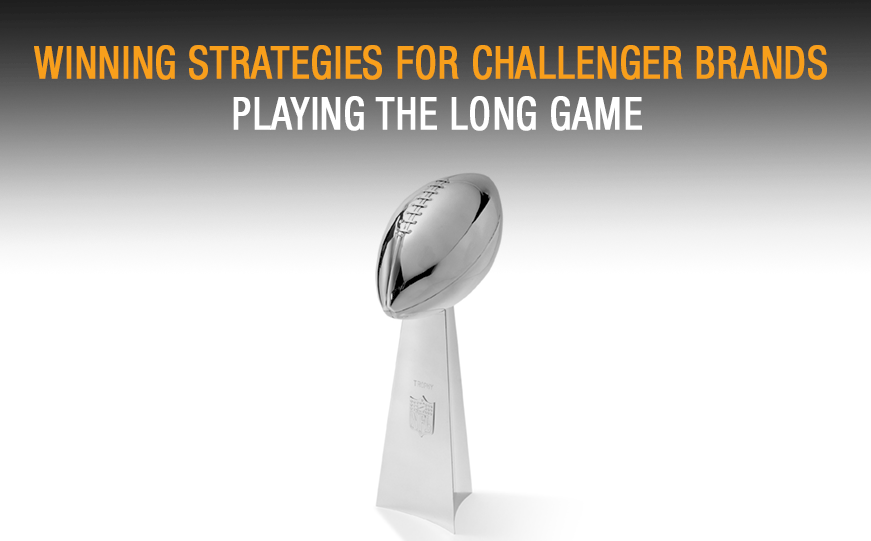Super Bowl LVI is just a few short hours away — where two longshot teams, the Cincinnati Bengals and Los Angeles Rams, will be going head-to-head (or rather, helmet to helmet) in a battle for the ultimate victory. This annual sporting event is a beloved American tradition that attracts — even those who wouldn’t generally consider themselves — football fans.
Close to 100 million people are expected to tune in later this evening, which is one of the reasons television commercials can cost millions of dollars for just one short ad impression. In fact, NBC announced that it has sold all spots for the bowl, some priced as high as 7 million for a 30-second commercial.
Yet the event also gives two football teams that have reached the pinnacle of their season one more chance to solidify their fandom.
Besides football, what do the Rams and Bengals have in common?
Well, in the marketing world, both teams would be considered “Challenger Brands.”
A challenger brand is not the undisputed market leader nor a niche brand (like having Tom Brady on your team). Instead, challenger brands are mission-driven and ambitious with a strong sense of purpose… and willing to do something bold, to break through.
Let’s take a look at the elements that build a challenger brand.
Play #1 – Tell a Great Brand Story
A few years ago, an Adweek survey found that 49 percent of marketers felt that the ability to craft a brand story or narrative… to be the most critical element of a challenger brand.
The Rams, for example, have a long and, at times, disruptive story. Founded in 1936 in Cleveland, the team then bounced around to several homes, including Los Angeles and Saint Louis, before landing back in the City of Angels in 2016.
Over the decades, the Rams have claimed three NFL championships… two of which occurred prior to the inception of the Super Bowl in 1967. And are the only franchise to win the title, while representing three different cities.
Now back in Los Angeles, will quarterback and former Georgia Bulldog Matthew Stafford be able to lead the franchise to its first Super Bowl win in more than two decades?
While we can’t know the game’s outcome, it certainly tells a captivating story of a historic team. Like the Rams, brands may have highs and lows, but by weaving a narrative that resonates — and tells an authentic story — audiences are very likely to remain engaged.
Play #2 – Be Yourself
Authenticity is a vital component to building strong relationships. Positioning a brand as “real” — and comfortable in its own skin — allows fans (or prospects and customers) to form a human connection.
Looking at the Bengals, it’s easy to see how the team has stayed true to its smashmouth brand of football for more than half a century.
The team has had many ups and downs. The 1990s and 2000s were undoubtedly a challenging time for the Bengals — they were even occasionally referred to as the “Bungles” during this period. But the franchise stayed the course, and tonight will play for the coveted Super Bowl title, taking their fans along for what is anticipated to be an exciting ride.
Like the Bengals, marketers representing a challenger brand must ensure that all messaging and marketing consistently resonates with authenticity. This doesn’t mean a brand can’t be refreshed… after all, the Bengals have gone through six logo updates in the last 54 years. What matters is that every outbound communication is genuine.
Play #3 – Give Back to the Community
Giving back to a community is nothing new. In fact, corporate social responsibility (CSR) and environmental, social and governance (ESG) programs have been growing in popularity with businesses of all sizes. This year’s Super Bowl contenders are no exception — both teams, as well as the rest of the NFL, actively perform charitable work in their communities.
While establishing a reputation for good deeds is an excellent method for a challenger brand to gain traction, challenger brands can also make a direct impact on the industry they serve. Keep Craft Alive is a wonderful illustration of how the building industry has come together to support a worthy cause — that benefits both the recipients and the industry — by helping to close the skilled labor gap.
Play #4 – Have a Purpose
Customers are much more likely to bestow loyalty upon a brand that shares their values. This leaves a large opening for a challenger brand to make its mark. Defining a purpose for a football team is fairly easy… the mission is to win games, culminating with taking home the prized Vince Lombardi trophy.
A manufacturer can also cultivate a purpose — one that instills loyalty from its employees, partners and customers — and the industry at large. Taking a position on an important cause like sustainable manufacturing practices, or committing to sourcing ethically produced raw materials… will allow a brand’s purpose to shine.
Need some help developing a strategy to make your brand the best it can be? Get in touch by sending an email to sk@kleberandassociates.com. We’d love to help you write a winning playbook.





